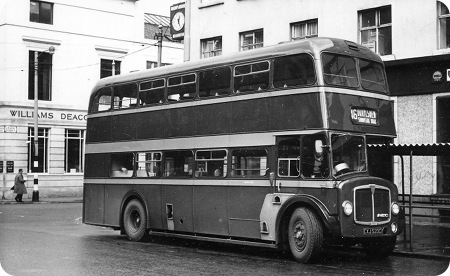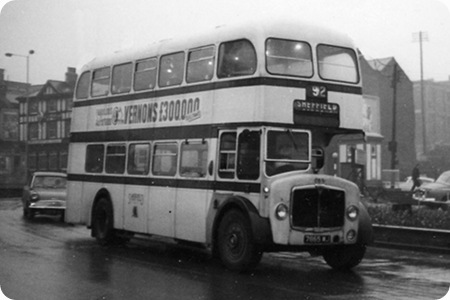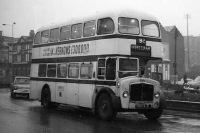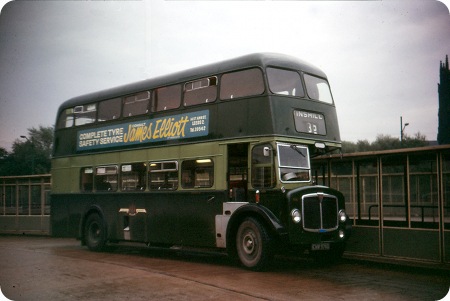A Mayne & Sons – AEC Regent V – CXJ 520C
A. Mayne & Sons
1965
Regent V 2D3RA
Neepsend H41/32R
Another independent bus operator but this time from the other side of the Pennines, A. Mayne & Sons operated in the Manchester area. I must admit I know very little about A. Mayne & Sons but I have two photographs of AEC Regent Vs that are worth posting, so if anybody as any information about them please leave a comment and I will add it as an update.
This Regent had a body built by Neepsend formally Cravens of Sheffield South Yorkshire and the livery at the time if I remember correctly was a dark red body with three pale green bands, although I do stand to be corrected if you know better.
A full list of Regent V codes can be seen here.
Maroon with turquoise bands would be more accurate. In later years they adopted a red and cream livery which was much more modern-looking, but far less distinctive! Maynes sold their bus operation to Stagecoach four or five years ago, but the name is kept alive by the coaching operation based on Warrington, which is actually the former Barry Cooper business.
There is a nice story that back in the 1930’s Manchester Corporation offered to buy out the Maynes business. The reply was that this was an amazing coincidence, as Maynes were thinking of making a similar offer to MCTD!
David Jones
Another piece of interaction between Maynes and the Corporation may be worth recording. In the mid-1960s Maynes had a half-share in Manchester’s service 46 to Droylsden, as shown above, and also their own unnumbered service along the main road to Audenshaw, which ran in competition with Manchester’s trolleybuses. Since the trolleys operated under light rail legislation and were outside the Road Service Licensing system, this made Maynes the sole licensed operator of local (as opposed to limited stop) buses on the stretch of main road beyond the Droylsden turnoff. When the Corporation wanted to run motor buses on the trolley routes, they had to apply for a licence, to which Maynes objected on the grounds that it was their patch! This promised a real David and Goliath battle in the traffic court, but sense prevailed and a deal was struck instead. Maynes got the other half of the 46 (which they had always wanted) and both their objection and their Audenshaw service were withdrawn.
Peter Williamson
I’m not familiar with the "half share" referred to by Peter – but as far as I recall only Maynes operated the 46 from Stevenson Square to Droylsden [Sunnyside Road]. During the early Selnec years Maynes continued to operate the route which was renumbered 213.
The story I was told was that Maynes started the 46 route when Droylsden was still being built and the roads unfinished. When the roads were completed Manchester then wanted to operate the route as well.
Maynes are said to have objected and won their case with the only restriction being passenger pickup only between City centre and Ancoats – outbound and passenger drop off only from Ancoats to City Centre – inbound.
It is also interesting to note that up till the recent acquisition of Maynes local bus services by Stagecoach – Maynes original route 46 [subsequently 213] was their only local service which I think remained as such until the deregulation era. They then increased the number of routes between Manchester and the Ashton area. Of note is that ALL their routes went via DROYSLDEN, maintaining their original commitment to service this area.
Roy Oldham [Expat in London Ontario Canada]
According to "The Manchester Bus" by Eyre and Heaps, the 46 was jointly operated by Manchester and Maynes from its inauguration in 1958. However, "half-share" wasn’t quite right, as I have found a table of joint services in 1962 which shows that the all-day service required 3 buses, of which 2 were Manchester’s and 1 Maynes.
Maynes original route – started in 1926 – was from Newton Street to Kershaw Lane, Audenshaw, although inbound buses always showed "Dale Street" as that was where the alighting point was.
Peter Williamson
I cannot comment on what the "Official" arrangements were between Maynes and Manchester – all I know is that I travelled between Stevenson Sq and Pollard Street quite frequently in the late 50s to late 60s and if not using the 215/216 trolley bus would take the 46. Invariably the return trip would be on the 46 as the trolley buses didn’t return via Pollard Street. If Manchester was in fact operating two out of three vehicles the odds are that I would get one, whereas in reality it was always a Maynes bus that came.
Roy Oldham
What became of the 46 service started in 1933 as a shuttle service from Edge Lane to Manor Road which connected with the existing Audenshaw service. As that area of Droylsden developed the service was extended gradually until it reached Sunnyside Road. The inconvenience of changing buses at Edge Lane became an issue and in 1958 the service was extended into the City and was numbered 46 by Manchester Corporation who became a joint operator in the ratios previously described. Peak hour extras were additional and provided by MCT in summer and Mayne’s in the winter.
As Peter has already said above, the 46 became worked exclusively by Mayne’s following the abandonment of the Manchester trolleybus system.
David Beilby
Recently Buses Mag published an interview with Julian Peddle who at one time was Traffic Manager at Maynes, seemingly the financial arrangement with MCTD was that they paid Mayne’s a mileage rate who then paid MCT all their takings, an arrangement very beneficial to Mayne’s !
Andrew Critchlow
14/09/11 – 07:58
I was born and bred in Droylsden near the cemetery. I used the 2 Maynes services for many years until I went to London in 1959. When the Edge Lane to Sunnyside Road changed to no 46 Limited stop from Stevenson Sq I came home from work on it. I used the 215 216 to go to the City as the Maynes was usually full by the time it got to our bus stop. Sometimes I used it to go home until no 46 started as the walk from the stop on Manor Rd was shorter. When at school I used the 216 to Ashton and the Hurst or Smallshaw Circular or walked to school from Ashton market. My uncle Bill was a driver for Maynes and if I was on his no 46 going home he used to stop earlier than the bus stop so my walk was shorter. My Dad and Arthur Mayne were friends.
Alan Bevins
07/11/11 – 12:21
I use to use the Maynes bus in 1965 to get to work. I use to meet my father and we would go together on the bus from Sunnyside Road terminal to Stevenson Square and visa versa. Brilliant service and always full of people travelling in the early mornings and again at night.
Marie Mckenna
10/11/11 – 07:42
I now have a copy of the Maynes book by Venture Publications, and it gives a slightly different version from the Manchester book of the joint working arrangements on the 46, namely two Maynes buses and one Corporation rather than the other way round. Plus the peak hour extras referred to by David B.
Peter Williamson
12/03/13 – 14:05
In addition to the services listed above, Maynes also had a road service licence for the Droylsden to Audenshaw Grammar school bus which was operated as what would be known now as a commercial service. I travelled to school on one of the Regent V’s every day on this service in the 1960’s.
Later I found myself driving Fleetlines and VR’s for Maynes for a short while – very nostalgic with Ultimate ticket machines.
Bill Lear
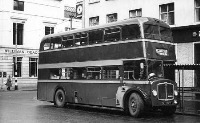 Vehicle reminder shot for this posting
Vehicle reminder shot for this posting
12/05/13 – 06:53
In 1964 I co-organised a student- teacher PD1 Leyland decker trip to Moscow from Manchester and as I wanted to keep my PSV licence going, I drove part-time for Maynes Buses from 1965 until I left Manchester in 1978. At the time I was teaching first at Manor Road Primary and then at Bishop Greer Secondary in Gorton. I lived on Greenside Lane near the Clockhouse terminus.
My inauguration was on GUF 678 – a Leyland PD1 slow gear change, so I had no problems in satisfying the requirements. (the drivers used to say "You can light a fag in between gear changes")
Mr Palmer was the manager under Arthur Mayne Jnr. and Alex was the mechanic. I drove on the last Kershaw Lane route (Dec 31st 1965) when they changed the route from trolley buses and swopped it for the 46 Droylsden Route.
My first trip from Droylsden, Market Street to Mayne Road was a different story. I was given an AEC Regent II FT 571 with a quick crash box change and I could not find any of the gears. I got the timing wrong and could not stop with the vacuum brakes at Edge Lane Traffic lights. With the help of the passengers they directed me to Mayne Road. Phew! I thought my days of driving for Maynes were over, but they were just beginning.
Last journey was on a Bristol VR to Rochdale VJA 666S.
First new bus was on a Sunday morning in July 1965 Regent V CXJ 520C. It had air brakes and stopping was very fierce. I remember one man hitting the bulkhead as I braked for Market Street on route to Kershaw Lane, Audenshaw. Oh Dear !!
I could share many comments as I drove all the fleet of deckers. My favourite was Ex Oxford synchro 27ft 7194 H. The pre selectors were also good ECY 874.
John Brown
04/12/18 – 07:17
Just a very small correction to John Brown (above), 7194 H had, prior to Maynes, been an AEC demonstrator, but I believe it did carry City Of Oxford Motor Services livery at the time.
David Call
Quick links to the - Comments Page - Contact Page - Home Page
